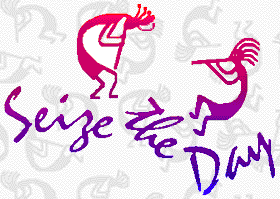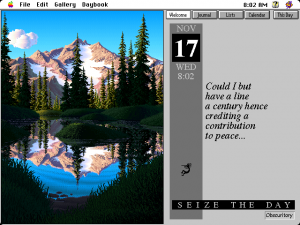Seize the Day 
Planner programs are one of the many relics of 90s computing. Nowadays we default to Google Docs, Outlook, iCal, or whatever we have on our phones, but before we synced up with the cloud, there was competing planning software. If computers could do nothing else right, they would still store contacts and remind you about your appointments. Each planner had to outdo the others with a richer feature set or a more exciting interface.
Enter Seize the Day. Forget the “daybook” part of this program. The biggest and best feature is its rotating gallery plug-in. Seriously, it’s beautiful.
Seize the Day is less a planner than a daily hotspot. Sure, it includes a calendar and an alarm scheduler, but it buries those features more deeply than you’d expect. Instead, the program is upfront with literary and artistic content to motivate your day, such as inspirational quotes, short biographies, and a journal. Everything has a grey, minimalist aesthetic that emphasizes words instead of icons, as if trying to declutter. Rather than setting alarms by going through drop-down menus, for instance, you just type the plain text into a window, and the software formats it for you. And none of the alarm sounds are especially attention-grabbing: you can choose from a handful of instruments or drumbeats which sound pleasant but are easily missable. The program is prettier and more captivating than others, even if it doesn’t work as well as a day planner.
The bulk of the program’s appeal, by far, comes from the animated gallery of “Living Worlds.” By default, Seize the Day includes a series of rotating stock images that appear in a separate window. However, it also comes with an additional set of twelve hauntingly beautiful pixel art landscapes, one for each month. They use a technique called “color cycling,” which changes the program’s 256-color palette to create effects like lighting, weather, and moving water. The scenes changes subtly with time. As night wears on, for instance, a castle up on a hill might light a few candles, then extinguish them as midnight approaches. Clouds creep across the sky. The sun sets and rises, realistically lighting each scene. Some days might bring heavier snowfall. Artist Mark Ferrari’s work is staggering and emotionally powerful, all within 256 colors.
Seize the Day resparked my imagination. I got such a kick out of staring into the distance and wondering, “Who’s the person who puts out the last light in that house?” “How big is this jungle anyway?” “What could be in those ruins?” The pixelated art can be mesmerizingly evocative, even frightening.
Want proof? Joseph Huckaby, one of the original developers of Seize the Day, has taken Ferrari’s art (from here and other games) and reassembled it online. (UPDATE: Now with time-of-day transitions! Thanks to Seize the Day director Ian Gilman for sharing the new version.) The images are still strikingly beautiful. You can drift off into their vistas. Seize the Day is a place you can go, where you can watch the rain and see your dreams reflected in the little pools of water that formed overnight.
As far as the planner part goes, it also has a to-do list. That’s pretty handy!
UPDATE (5/3/19): Gilman, Huckaby, and Ferrari have released an updated version of Living Worlds as a phone app. Mirroring the transition from planner software to phones, this is a great new format for Living Worlds that keeps the spirit of the original program, as it gives you an excuse to visit it multiple times a day.
(This article was partially revised on May 3, 2019.)



Thanks for this great write-up! I’ve got more information on my site:
http://iangilman.com/software/seizetheday.php
…including a link to Joseph’s new more full-featured version:
http://www.effectgames.com/demos/worlds/
I’m finally making an updated version of the Seize the Day Living Worlds for modern mobile devices! https://medium.com/@iangilman/living-worlds-for-ios-android-46b4a4e9b048
Hey guys! Don’t know how I missed this very nice write-up until now, but THANKS for your kind words about my landscapes. Always glad to hear that they brought enjoyment to someone. :]
Absolutely gorgeous. I just bought the Android app. Thank you Ian and Mark!
Oh man, my father gave this program to me for my desktop years ago, I loved it. Oh has technology changed since then but I have often thought of this program. So glad to have found it again . Hoping to put this on my iPad .